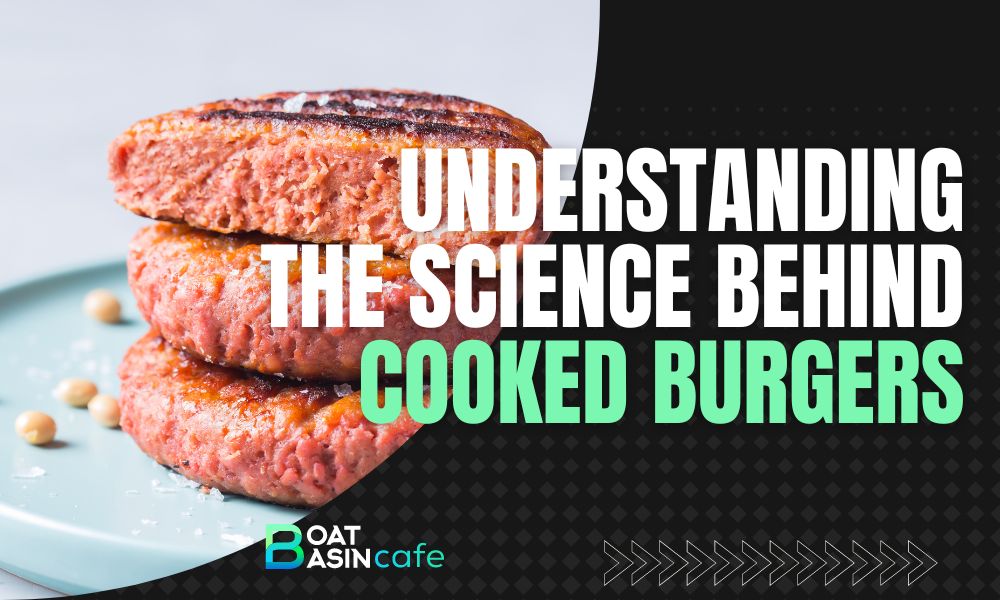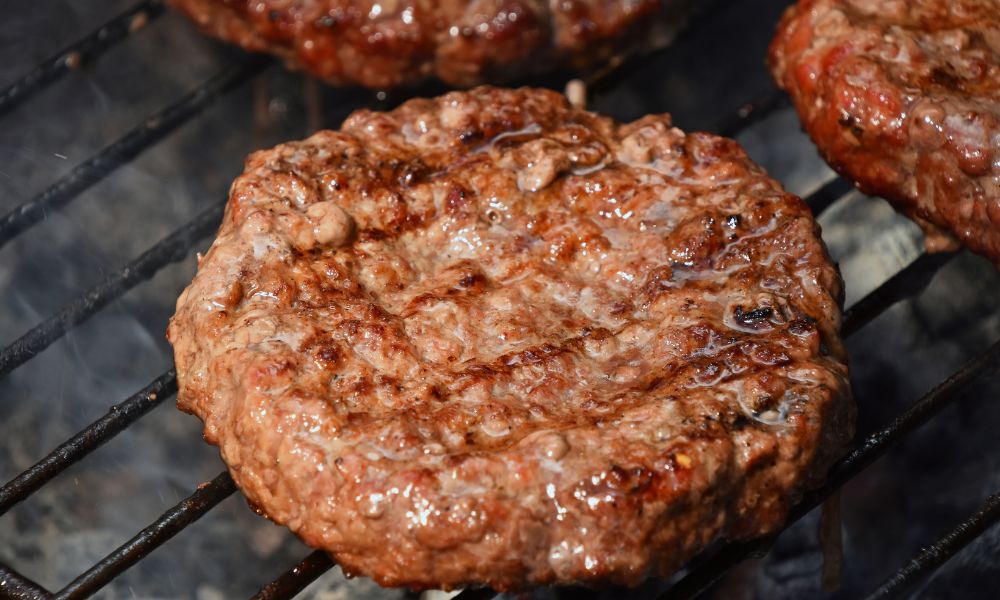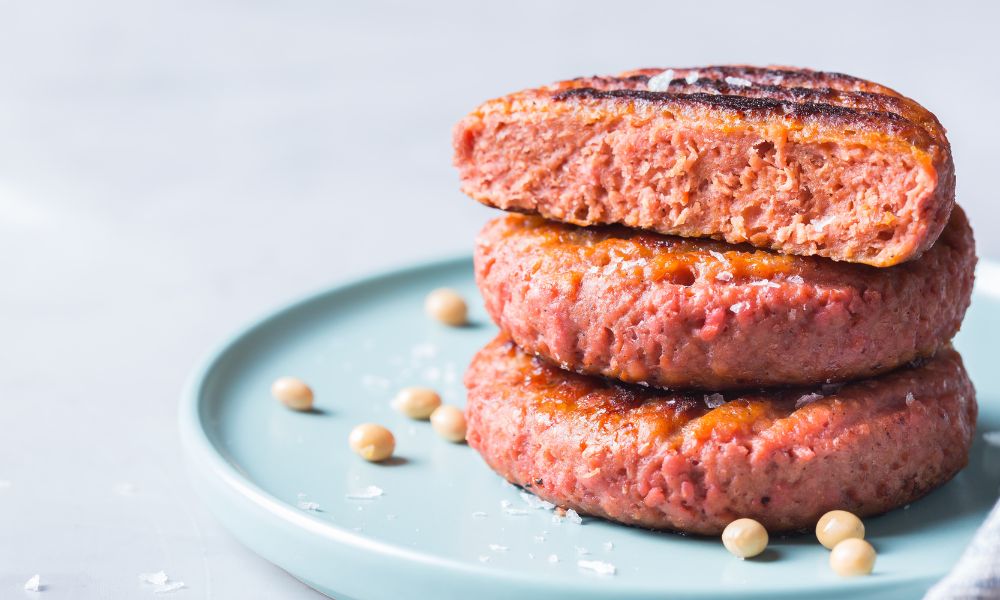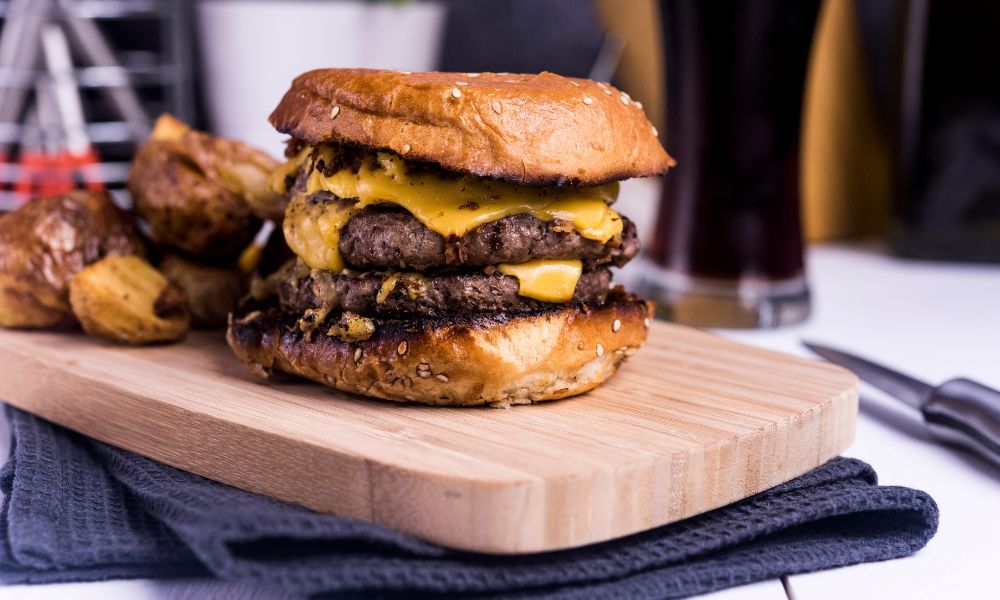Get ready to solve the mystery of the century – burger pink! Dive into the science behind cooked burgers, exploring the factors that affect burger doneness, health, and flavor – and ultimately, cook the perfect burger.

The Science of Burger Pink
At first glance, you might think that a cooked burger pink in the center is an indication of undercooked meat. Sometimes, though, you’ll find that even a well-cooked burger retains a pink hue at its core. So, what gives? The answer lies in myoglobin, a protein found in the muscle tissue of animals, which plays a crucial role in determining the color of meat. Presence of myoglobin in meat helps to determine the various shades of pink that can be observed during the cooking process.
The Role of Myoglobin in Meat Color
Myoglobin binds with oxygen in an animal’s muscle tissue, giving the muscle its characteristic red color. When meat is cooked, myoglobin undergoes chemical changes that affect its color. At low temperatures (below 140°F), myoglobin remains red. As the temperature rises (140°F – 170°F), it turns brown.
However, some factors may cause cooked meat to retain a pink hue even at higher temperatures.
Chemical reactions with gases in the air or during the cooking process can cause myoglobin to change back to the pinkish color even if the meat is fully cooked – this is known as the premature browning effect. Nitric oxide from the grilling flame can cause this color transformation as well.
On the flip side, bacterial activity in undercooked meat sometimes leads to the same premature browning, resulting in a deceptively cooked appearance while the inside remains pink and potentially dangerous to consume. It’s essential to understand the difference between safely cooked burger pink and an undercooked burger that could put your health at risk.
Understanding Burger Doneness

Determining the perfect level of burger doneness involves understanding the different stages a patty goes through as it cooks. From rare to well-done, each stage corresponds to a specific burger temperature at which the meat changes color, texture, and doneness.
The Different Levels of Doneness
- Rare burgers are cooked to a temperature of around 120°F – 130°F. At this stage, the patty is red and soft in the center, becoming browner and firmer towards the edges.
- Medium-rare burgers are cooked to approximately 130°F – 140°F, with a slightly pink center that’s warm and somewhat firm.
- Medium burgers reach 140°F – 150°F, featuring a uniform pink hue throughout the patty. This level of doneness is ideal for those who want a juicy, tender burger without any redness.
- Well-done burgers are cooked to a temperature of 160°F or higher. The meat should be brown throughout, firm, and not as juicy as medium or medium-rare burgers.
You may wonder, “is it safe to eat medium-rare burgers?” It ultimately depends on the quality and freshness of the meat. Understand how long you can safely store raw hamburger meat in the fridge by checking out this useful guide.
The Importance of Cooking Temperatures
To ensure the burger is thoroughly cooked, use a meat thermometer to measure the internal temperature. Insert the probe into the thickest part of the patty to get an accurate reading.
Following the recommended burger temperatures helps eliminate dangerous bacteria that could cause foodborne illnesses. Ground beef should be cooked to at least 160°F, as this temperature effectively destroys bacteria like E. coli and Salmonella.
Determining Burger Doneness Without Cutting Into It
One popular technique to check burger doneness without cutting open the patty is the “face method.” Gently press on the burger patty, comparing the feel to different parts of your face:
- Forehead: A firm, tense surface (similar to a well-done burger)
- Cheeks: A soft, yielding surface (like a medium-rare patty)
- Chin: A texture between the forehead and cheeks (akin to a medium burger)
Keep in mind, this method isn’t infallible, so using a meat thermometer remains the most accurate way to gauge doneness.
Factors Influencing Burger Doneness

Several factors can affect how quickly a patty cooks and whether it reaches the desired doneness. Consider the following when planning to cook your burgers.
Thickness and Size of Burger Patty
A thicker burger patty takes longer to cook than a thinner one. Patties also tend to shrink as they cook, so it’s essential to consider the starting size of your patty before you begin. A thicker burger patty size provides a better chance of achieving a juicy, pink center, especially when you’re shooting for medium or medium-rare doneness.
Cooking Method
The way you cook your burgers also impacts the doneness. Grilling and pan-searing are popular methods, both providing deliciously charred flavor. Broiling involves high heat from above, cooking the meat quickly while retaining its juiciness. Each technique yields different results, so consider the desired outcome when choosing your cooking method.
Resting Time After Cooking
To maintain the juiciness of your burger, allow it to rest for a few minutes after cooking. This helps redistribute the juices throughout the patty, ensuring a succulent, tender burger every time.
Quality and Freshness of the Meat
Lastly, the quality and freshness of the meat play a role in achieving the perfect burger pink. Fresh, high-quality ground beef offers the best taste and texture, not to mention safety when cooking to medium or medium-rare doneness.
So far, we’ve uncovered the secrets behind burger pink and how it relates to the doneness of your patty. Stay tuned for the second half of this article, where we’ll delve into cooking techniques for perfectly cooked burgers, seasoning options, and gourmet topping ideas. Plus, get all your burning burger questions answered in our FAQ section. Happy cooking!
Cooking Techniques for Perfectly Cooked Burgers

Now that we’ve cracked the code on burger pink and doneness, it’s time to get down to the fun part – cooking! Armed with knowledge, you’ll never wonder, “Is it safe to eat pink in a burger?” again. Let’s dive into the best way to cook burgers for maximum juiciness and flavor.
Step-by-Step Guide for Grilling Juicy Burgers
- Preheat your grill to high heat, aiming for a cooking temperature of around 450°F to 500°F.
- Shape your ground beef into evenly sized patties, about ¾ inch thick. If you want a juicy burger with a pink center, opt for a thicker patty.
- Lightly oil the grates of your grill and place the burger patties on the hot surface. Cook for 4 to 5 minutes on one side.
- Flip the burgers using a spatula and cook for another 4 to 5 minutes or until the desired doneness is reached. Avoid pressing down on the patty, as this will cause the juices to escape and make the burger dry.
- If desired, add cheese and cook for an additional minute to allow it to melt.
- Let the burgers rest for a few minutes before serving to maintain their juiciness.
Tips for Achieving the Ideal Doneness Level
- Start with high-quality, fresh ground beef for the best taste and texture. Understand how long you can safely store hamburger meat in the fridge using this guide.
- Adjust the cooking time based on the thickness of the burger patty and your desired level of doneness.
- Use a meat thermometer to measure the internal temperature of the patty, ensuring it’s cooked to a safe level.
- Allow the burger to rest for a few minutes after cooking to redistribute the juices and maintain its juiciness.
Seasoning and Flavoring Options for Enhanced Taste
Before grilling, season your burger patties with salt and pepper to enhance their natural flavors. If you’re feeling adventurous, try experimenting with different seasonings like garlic powder, onion powder, paprika, or cayenne pepper. You can also mix herbs like parsley, thyme, or oregano into the ground beef for added depth and flavor.
Recommendations for Burger Toppings and Condiments
The sky’s the limit when it comes to burger toppings and condiments. Elevate your burger game with the classics like lettuce, tomatoes, onions, pickles, and cheese. Or branch out with options like sautéed mushrooms, caramelized onions, avocado, bacon, or even pineapple.
Be creative with your choice of condiments as well. Ketchup, mustard, and mayonnaise are mainstays, but you can also try barbecue sauce, sriracha, aioli, or homemade relishes.
FAQs
Why is the inside of my burger pink?
The color of cooked meat is determined by the protein myoglobin and its reaction to heat. The presence of myoglobin and other factors, such as chemical reactions or bacterial activity, can cause burger pink, indicating various levels of doneness.
Is it safe to eat a burger that is pink in the middle?
It depends on the quality and freshness of the meat, as well as the internal temperature it’s been cooked to. Ground beef should be cooked to at least 160°F to kill harmful bacteria. Use a meat thermometer to ensure the burger is cooked to a safe temperature.
How can I determine if a burger is fully cooked?
Using a meat thermometer is the most accurate way to determine if a burger is fully cooked. Insert the probe into the thickest part of the patty to get an accurate reading.
Can I achieve a juicy burger without it being pink?
Yes, by cooking the burger to a medium or medium-well temperature, you can still enjoy a juicy, tender burger without a pink center. Take care when grilling, as cooking to well-done may result in a drier burger.
What are the risks associated with undercooked burgers?
Consuming undercooked ground beef may lead to foodborne illnesses caused by bacteria such as E. coli or Salmonella. Ensure your burgers are cooked to a safe internal temperature of 160°F or higher.
Conclusion
Congratulations, you’re now a burger pink phenomenon expert! Wield your newfound knowledge of burger doneness, cooking methods, and safety to elevate your burger game to new heights. Go forth and grill with confidence, knowing that you have the key to crafting the ultimate juicy, flavorful, and perfectly cooked burger. Happy cooking!